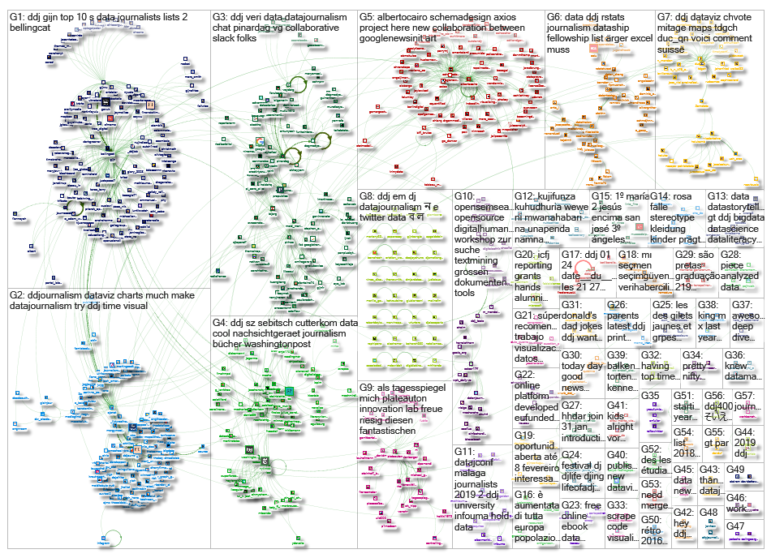What’s the global data journalism community tweeting about this week? Our NodeXL #ddj mapping from January 21 to 27 finds @schemadesign and @GoogleTrends teaming up to visualize news cycles in 2018, the @washingtonpost‘s flyover tour of the entire US-Mexico border, and two football-related visualizations: @ftblsm‘s history of football and @NZZ‘s analysis of whether football coaches Jose Mourinho and Julen Lopetegui should have been sacked.
Mapping Media Attention Span
How long do significant news events stay in public consciousness? “The Lifespan of News Stories” visualization, a collaboration between Schema Design and Google Trends, shows the level of public attention to 2018 events by measuring a story’s “Google search interest” over time.
Wonderful rich analysis and visualization of the lifespan of news stories from @schemadesign @GoogleTrends @axios https://t.co/UXVb0zTbxf pic.twitter.com/kLMvy84YQS
— Ross Dawson (@rossdawson) January 28, 2019
Bird’s Eye View of US-Mexico Border
“BUILD A WALL & CRIME WILL FALL,” tweeted US President Donald Trump a few days ago. In the midst of the debacle over Trump’s promise to build a wall along the US-Mexico border, the Washington Post’s interactive flyover above the entire border, published in October last year, is as relevant as ever.
Amazing work by @washingtonpost on U.S/Mexico Border wall -> https://t.co/U0MsdtApy8 This work is also another great example of how change geographical standards for better #dataviz #ddj pic.twitter.com/qBGSzPuek6
— Daniele Palumbo (@Danict89) January 21, 2019
Golf, Public Parks and Vineyards in Switzerland
How do the Swiss use their land? Tribune de Genève mapped out the land used for housing and infrastructure, farms, forests and more in Switzerland. Did you know Swiss golf courses take up more space than public parks? And their vineyards cover more land than all public buildings and their adjoining land?
Voici comment la Suisse utilise son territoire https://t.co/PDLixudNoQ #mitage #CHvote #maps #dataviz #ddj @tdgch🇨🇭🏢🌾🌲🏔 pic.twitter.com/Cv9ciE00j7
— 𝙳𝚞𝚌-𝚀𝚞𝚊𝚗𝚐 𝙽𝚐𝚞𝚢𝚎𝚗 (@duc_qn) January 21, 2019
Open Data in Schools
Little attention is usually given to the use of open data in the field of education. However, more and more European societies have acknowledged this potential and have started projects to introduce open data in the school curriculum, including Northern Ireland, Germany and Switzerland. This article in also available in Turkish.
Education: #OpenData in Schools ➡️
How Open Data can benefit educational purposes? https://t.co/MigFuM9kCS via @EU_DataPortalShare your initiatives https://t.co/gDyiq65V95 pic.twitter.com/oI8UYgAALj
— ODI Madrid (@odi_madrid) January 25, 2019
Health Investment in Brazil
Multimedia journalist Cristian Weiss analyzed investments in health by each municipality in the state of Santa Catarina in southern Brazil. His mapping shows which states invested, from the most to the least. Municipalities in the smallest cities, with less than 5,000 inhabitants, usually spent almost twice the national average amount on the health of each citizen.
As cidades que mais investiram em saúde em SC (e as que menos gastaram também). A pequena Paial, no Oeste, tem o maior investimento per capita. Camboriú tem o menor. Veja no Caixa de Dados https://t.co/Rs47fA6Si1 #saude #datajournalism #jornalismodedados #santacatarina #ddj pic.twitter.com/vUAhhCgi3d
— Cristian Weiss (@Cristian_Weiss) January 21, 2019
Visualizing the History of Football
Computational designer Carlo Zapponi and football writer Francesco Mistrulli published a visual essay last month on the careers of almost all the football players from 1920 to today. (For you Yanks out there, we’re talking about soccer here.) Zapponi now explains the process of how they built the story and adapted it for mobile. They also included an exploratory tool where you can search across their entire database of more than 100,000 footballers to see your favorite player’s career visualized.
An interesting and instructive account of the development of a #data-driven #story.#datajournalism #digital #storytelling https://t.co/M3ehYkLcI1
— Alex Gorelik, Ph. D. (@Doc_G_) January 25, 2019
Bad Luck or Bad Coach?
Recently, Jose Mourinho was fired by Manchester United and Julen Lopetegui was sacked by Real Madrid. But were the football teams’ poor performance due to bad luck or a bad coach? Neue Zürcher Zeitung analyzed the statistics to see if the two sackings were justified.
We analyzed which coach was or should be rightfully fired. And who just had a lot of bad luck. Superb viz by @wiederkehra, great team effort with @NZZSport and Raphael Flepp who I met at a conference @uzh_crsa. #ddj #dataviz https://t.co/cu7AvyCs4g pic.twitter.com/mytF2QjSXh
— Haluka Maier-Borst (@HalukaMB) January 24, 2019
Producing the Data Journalism Handbook
Jonathan Gray and Liliana Bounegru, editors of the Data Journalism Handbook 2.0 beta version, talked to the European Journalism Centre about the process of producing the book. From capitalizing on snowballing leads to categorizing readers to ensuring diversity in the content and contributors, it was a collaborative journey. Read the first 21 chapters here and a preview of all chapters here. The full version is slated to be released this September.
‘Snowball editorial’: the journey that brought you the Data Journalism Handbook 2 https://t.co/2xya95zYsu via @ddjournalism #ddj
— Disrupt MediaLab (@dmedialab) January 21, 2019
Eurasian Data Storytelling Contest
Civic tech organization ForSet is organizing a Eurasian Data Stories contest. The competition is open to data storytellers from 20 countries: Armenia, Azerbaijan, Belarus, China, Georgia, Hungary, Iran, Kazakhstan, Kyrgyzstan, Moldova, Mongolia, Poland, Romania, Russia, Slovakia, Tajikistan, Turkey, Turkmenistan, Ukraine and Uzbekistan. Winners get either €1,000 or a free entrance to DataFest Tbilisi 2019.
If you're a storyteller & have a passion for data, this competition is for you! https://t.co/eGEIPzTj8M pic.twitter.com/F7NNzJ9WBv
— ForSet (@ForSetGe) January 21, 2019
Tagesspiegel Innovation Lab Launch
Tagesspiegel’s creative and innovative data journalism projects are no stranger to our weekly Top 10 #ddj roundups. This year, it is upping its game by launching the Tagesspiegel Innovation Lab, which will focus on data-driven reporting. The interdisciplinary team, headed by Hendrik Lehmann, is staffed with software developers, editors and artificial intelligence experts.
Das ist ja toll, @Tagesspiegel!
„Ich freue mich sehr, dass wir mit dem ‚Tagesspiegel Innovation Lab‘ den digitalen Journalismus mit spannenden Projekten voranbringen können.“ @LorenzMaroldt
Herzlichen Glückwunsch an @plateauton! https://t.co/lzqrWhVEtx
— Friederike Busch (@rike_tweet) January 24, 2019
Thanks, once again, to Marc Smith of Connected Action for gathering the links and graphing them.
 Eunice Au is GIJN’s program coordinator. Previously, she was a Malaysia correspondent for Singapore’s The Straits Times, and a journalist at the New Straits Times. She has also written for The Sun, Malaysian Today and Madam Chair.
Eunice Au is GIJN’s program coordinator. Previously, she was a Malaysia correspondent for Singapore’s The Straits Times, and a journalist at the New Straits Times. She has also written for The Sun, Malaysian Today and Madam Chair.

